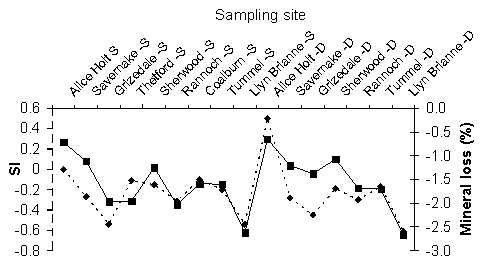Summary
The study
The mineralogical content of forest soils has a major influence on the calculations of both forest nutrient and pollutant budget studies. However, whilst it is possible to measure the mineralogical content within soil samples, their rates of decay and thus contribution to the soil chemistry is poorly understood.
To help address this lack of information, in 1997, 7 types of reference mineral samples were buried in a selection of different soil horizons at 10 of the Level II monitoring sites. The soil horizons were selected to provide a diverse range of chemical environments. At each site, replicate sets were buried to allow recovery at different time intervals. The buried minerals varied in their chemical stability, ranging from the highly soluble Gypsum, through Apatite, intermediate Micas minerals to the more stable Microcline and Tourmaline.
The results
The minerals were recovered after 1, 3, 5 and 10 years.
Differences in the rates of mineral loss were seen not only between sites, but also individual soil horizons. For some of the mineral types used, chemical analysis of soil solution collected from the monitoring sites by tension lysimeters, allowed geochemical modelling of the mineral’s saturation index (SI) within the soil solution. This saturation value can be used as an indicator of the mineral’s susceptibility to dissolution or precipitation within that soil environment.
Good correlations have been found for comparative predicted rates of loss from the model with actual weight losses of mineral. An example is shown below for the mineral ‘Tourmaline’.

Final analysis of the minerals recovered after the 10-year period of this project is ongoing.
